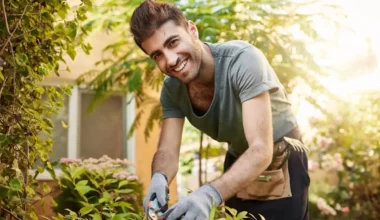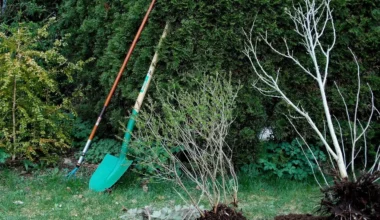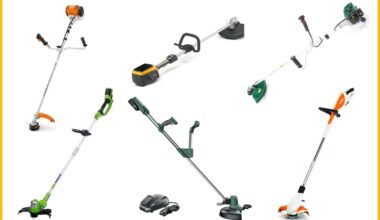Tools to loosen soil are essential arsenals in any garden shed. As gardeners, we know that soil is the foundation of any healthy garden. But, if the soil is too hard or too clay-like, it’s tough to work with and impossible to grow plants in.
So, how do you loosen the soil to make it easier to work with and to help your plants grow?
In this post, I present the seven (7) best gardening tools that are available to loosen the soil easily and efficiently.
Why is it Important to Loosen Soil?
There are many reasons why it is important to loosen the soil.
Loosening soil allows water, air, and nutrients to reach the roots of plants more easily. This helps the plants grow and produce crops.
Additionally, loosening soil allows pests and diseases to spread less easily. By loosening the soil, we make it easier for plants to take in vital nutrients and water.
The ideal soil texture for garden growth is somewhere in the middle between sandy and clay. This means that the soil has a mixture of both small and large particles.
7 Best Garden Tools To Loosen Soil
A healthy garden requires good soil. Soil needs to be loose enough so that water and nutrients can reach the plants’ roots.
However, soil can be difficult to loosen without the right tools. Here are the seven best gardening tools that are available to loosen soil:
Garden Spade
A garden spade is a traditional tool for loosening hard soils in gardens and yards.
It has a blade on one end and a handle on the other. The blade helps cut through the soil while the handle provides leverage for moving it around. Garden spades come in various sizes so you can find one that is comfortable to use.
Pros: Advantages of using a spade include its ability to cut through hard soils, its narrow blade that helps avoid damage to plants, and the fact that it is easy to maneuver. Garden spades are also lightweight and easy to carry around, making them ideal for use in tight spaces.
Cons: There are a few disadvantages to using a spade to loosen the soil.
One disadvantage is that if the soil is too hard, the spade will simply injure or bruise your hands, rather than loosen the soil. Another disadvantage is that if you’re using a spade on wet ground, the spade will likely slip and cause you to fall.
Garden Hoe
A garden hoe is an essential gardening tool that can be used to loosen the soil. It has a blade on one end and a handle on the other end.
The hoe’s handle provides leverage for moving the tool while the blade aids in cutting through the clay soil.
Hoes come in a variety of shapes and sizes, so it is best to choose the one that is comfortable for you to use.
Pros: A garden hoe is a handy tool with many advantages for loosening the soil.
- The edges are nice and sharp and will last for a long time.
- It cuts through the soil easily, which makes it easier to remove clumps of dirt.
- The hoe also has a curved blade, which helps break up the soil and make it easier to remove.
- The blade and socket are welded together and will not separate.
Cons: There are a few disadvantages of using a garden hoe to loosen the soil.
Firstly, the hoe can cause damage to the surface layers of the soil if used incorrectly.
Secondly, hoes are not very effective at breaking up large clumps of soil, which is necessary for loosening soils that are compacted or hard. Rocks can cause the blade to nick.
Finally, hoes can be time-consuming and labor-intensive to use, which can limit their usefulness in larger gardens.
Garden Weasel
The Garden Weasel is the world’s best garden cultivator, and its unique design makes it a must-have tool for every gardener.
Its fast loosening and aerating action loosen and aerate soil two to three times faster than a garden fork or digging fork, making it the perfect tool for quick maintenance tasks in your garden.
This garden tool is lightweight and easy to use, making it a good choice for larger areas of planting or loosening compacted soil in your vegetable garden.
It has an offset handle that makes it easier to use with either hand, and its carbon steel construction ensures durability.
Pros: The weasel’s sharp claws can penetrate the soil, breaking it up and allowing air and water to reach the plant roots. This helps improve plant growth and yields.
Additionally, the weasel’s furrows in the soil create channels that allow water, organic matter and nutrients to reach the plants more easily.
Cons: The main disadvantage is that the weasel can damage the plant roots if it digs too deeply.
Garden Auger Drill
Another digging tool that can be used to loosen soil for sowing seeds is called an auger. An auger looks like a large screwdriver with several blades attached at different angles along its shaft.
When you rotate the auger shaft, these blades slice through the soil creating holes big enough for seeds to germinate in.
Pros: This tool has many advantages:
It can penetrate deeply into the ground and rotate. This combination makes it ideal for loosening stubborn soils.
Additionally, a garden auger drill can be used in tight spaces, making it perfect for working with small gardens or areas that are difficult to access.
Cons: One of the disadvantages of using a garden auger drill is that it requires a lot of force to operate.
Additionally, if you’re not careful, you could damage the roots of your plants by drilling too deep.
Hand Trowel
A hand trowel is a great tool to have if you’re looking for a gentle way to loosen the soil. It’s also very easy to use, so even beginners can get the job done. A garden trowel is frequently the first tool given to a young gardener, and seasoned professionals are quick to recommend their preferred brand.
Pros: There are a lot of advantages to using a hand trowel, including the fact that it’s very effective at loosening soil.
It also doesn’t require as much strength as other tools do, so it’s perfect for those who are not very strong.
For prolonged use, the handle is ergonomic and comfortable and the handle’s hole makes organization simple.
Cons: One downside to hand trowels is that they aren’t as efficient as garden tractors when it comes to turning over the soil. This means that you may need to use more tools to achieve the same results.
Garden Tillers
Garden tillers are the perfect tool for those who want to loosen the soil quickly and easily. They’re also very versatile, so you can use them to turn over the soil, break up clumps, and even remove weeds.
There are different types of tillers available in the market. They can be put in four major categories thus,
- Corded electric rototillers
- Cordless electric tillers
- Gas rototillers
- Hand tillers
Corded electric rototillers
Corded electric rototillers are a popular choice for loosening soil, as they have a wide range of speeds and can penetrate deep into the ground. They can also be used to remove large amounts of soil in a short amount of time, making them ideal for larger projects.
Some drawbacks to corded electric rototillers are that they are often heavy and require some effort to operate, and they can be loud.
Cordless electric tillers
Cordless electric tillers allow the gardener to work more quickly and easily, which can be especially beneficial in tight spaces or areas with limited access.
Additionally, these tools are often less expensive than traditional tillers, making them an affordable option for smaller gardens or those on a budget.
Gas Rototillers
When it comes to preparing your garden for planting, a gas rototiller can be a huge help. Gas rototillers are heavier than electric rototillers. They are better suited to activities such as integrating dense soil and amendments due to their larger weight and enhanced power.
There are a few things to keep in mind when using the machine. Always make sure to read the manufacturer’s instructions carefully before you use one. Gas rototillers can be very loud so it’s a good idea to wear ear protection when using one.
Hand Tillers
Hand tillers are a good option for those who want to work with their hands. They are easy to use and can be used to loosen soil and create a better surface for planting. Hand Tillers are also affordable, making them an ideal option for smaller gardens or those on a budget.
Hoe and Garden Hand tillers and Rotary hand tillers are examples of hand tillers ideal for loosening soil and adding soil amendments to enrich it. The hoe and garden tiller combo is a hand tool that has a hoe on one side and a cultivator rake on the other side.
Pros: One of the main benefits of using a garden tiller is that it’s very powerful. This means that it’s capable of doing a lot of work in a short amount of time, which is great if you’re looking to speed up the process.
Cons: One downside to garden tillers is that they can be quite heavy and difficult to use if you don’t have a lot of strength in your arms and experience.
Digging Fork
A digging fork is a tool that can be used to loosen the soil quickly and easily. It’s perfect for smaller areas, so it won’t take too long to get the job done, and it’s very easy to use.
Pros: One of the benefits of using a digging fork is that it’s very effective at loosening soil. Additionally, it’s straightforward to use, so you won’t have to spend hours figuring out how to use it.
Cons: One disadvantage of using a digging fork is that it can be difficult to maneuver around tight corners or obstacles. Additionally, if you’re not careful, you could damage plants or roots when using this tool.
What are the Benefits of Using the Tools to Loosen Soil?
There are many benefits to using the tools to loosen the garden soil.
Primarily, these tools make it easier to remove plant material and other objects from compact soil.
Additionally, they can help improve drainage and aeration in heavy clay soil. In some cases, they can also be used to create new openings in the tough soil of your garden bed.
Tips for Loosening Soil Using Tools
1. Use a spade to loosen the soil around roots and plants.
2. Always put on your gardening gloves when using these tools.
2. Dig a shallow hole and use a fork or spade to loosen the soil before tilling it.
3. Use a rake to remove leaves, sticks, and other debris from the soil before aerating, loosening the soil, and planting to prevent the spreading of weed seeds.
4. As part of lawn care and gardening, water your garden at night and let it soak up what it can since dry soil is difficult to loosen and aerate.
5. Fertilizing immediately after aerating and loosening the soil is recommended.
6. Compact the soil around the roots of plants with your hands before planting.
Ultimately, the tools mentioned in this article provide many benefits for both the gardener and the land itself. By using the right tools and techniques, you can loosen rocky soil for maximum yield and garden growth. So, get out there and start loosening the soil today!



